ZHCSI92D May 2018 – November 2020 TAS5805M
PRODUCTION DATA
- 1 特性
- 2 应用
- 3 说明
- 4 Revision History
- 5 Device Comparison Table
- 5 Pin Configuration and Functions
-
6 Specifications
- 6.1 Absolute Maximum Ratings
- 6.2 ESD Ratings
- 6.3 Recommended Operating Conditions
- 6.4 Thermal Information
- 6.5 Electrical Characteristics
- 6.6 Timing Requirements
- 6.7
Typical Characteristics
- 6.7.1 Bridge Tied Load (BTL) Configuration Curves with 1SPW Mode
- 6.7.2 Bridge Tied Load (BTL) Configuration Curves with BD Mode
- 6.7.3 Bridge Tied Load (BTL) Configuration Curves with Ferrite Bead + Capacitor as the Output Filter
- 6.7.4 Parallel Bridge Tied Load (PBTL) Configuration with 1SPW Modulation
- 6.7.5 Parallel Bridge Tied Load (PBTL) Configuration with BD Modulation
- 7 Parameter Measurement Information
-
7 Detailed Description
- 7.1 Overview
- 7.2 Functional Block Diagram
- 7.3 Feature Description
- 7.4 Device Functional Modes
- 7.5 Programming and Control
- 7.6 Register Maps
- 8 Application and Implementation
- 9 Power Supply Recommendations
- 9 Layout
- 10Device and Documentation Support
- 11Mechanical, Packaging, and Orderable Information
封装选项
请参考 PDF 数据表获取器件具体的封装图。
机械数据 (封装 | 引脚)
- PWP|28
散热焊盘机械数据 (封装 | 引脚)
- PWP|28
订购信息
6.7.1 Bridge Tied Load (BTL) Configuration Curves with 1SPW Mode
Free-air room temperature 25°C (unless otherwise noted.) Measurements were made using TAS5805MEVM board and Audio Precision System 2722 with Analog Analyzer filter set to 20-kHz brickwall filter. All measurements taken with audio frequency set to 1 kHz and device PWM Modulation mode set to 1SPW mode with Class D Bandwidth = 120 kHz for 576 kHz Fsw and Class D Bandwidth = 175 kHz for 768 kHz Fsw (Listed in Register 0x53) unless otherwise noted.
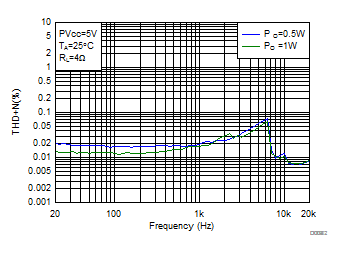
| PVDD = 5 V | 4.7µH+0.68µF | |
| FSW = 576 kHz | 1SPW Modulation | Load = 4Ω |
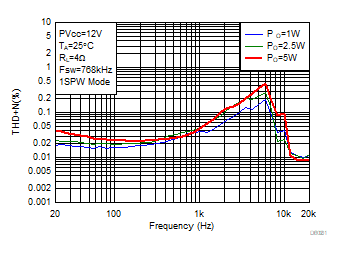
| PVDD = 12 V | 10µH+0.68µF | |
| FSW = 768 kHz | 1SPW Modulation | Load = 4Ω |
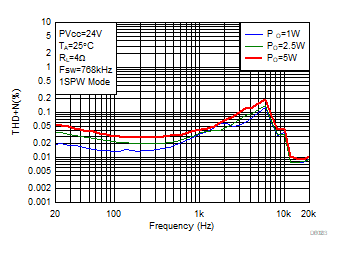
| PVDD = 24 V | 10µH+0.68µF | |
| FSW = 768 kHz | 1SPW Modulation | Load = 4Ω |
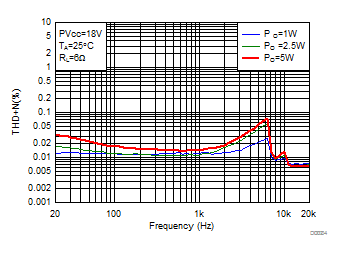
| PVDD = 18 V | 10µH+0.68µF | |
| FSW = 768 kHz | 1SPW Modulation | Load = 6Ω |
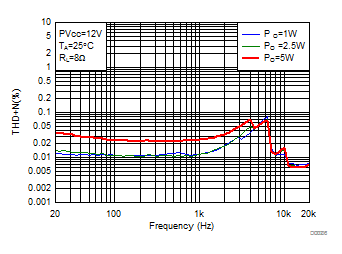
| PVDD = 12 V | 4.7uH+0.68uF | |
| FSW = 768 kHz | 1SPW Modulation | Load = 8Ω |
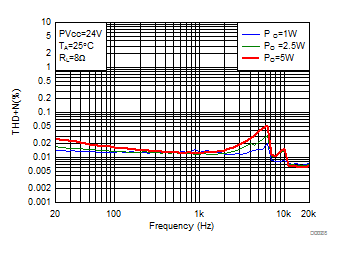
| PVDD = 24 V | 10µH+0.68µF | |
| FSW = 768 kHz | 1SPW Modulation | Load = 8Ω |
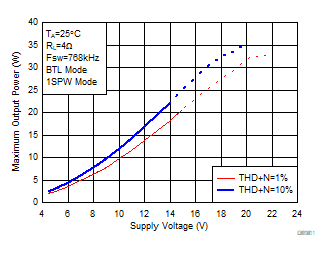
NOTE: Dashed
lines represent thermally limited region for the continuous output power.
Figure 6-13 Output Power vs Supply Voltage-BTL| PVDD = 4.5 V~24V | 10µH+0.68µF | |
| FSW = 768 kHz | 1SPW Modulation | Load = 4Ω |
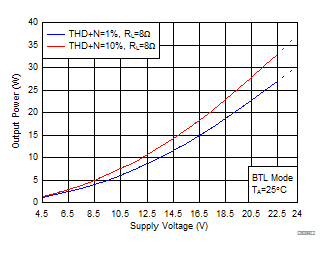
| PVDD = 4.5 V~24V | 10µH+0.68µF | |
| FSW = 768 kHz | 1SPW Modulation | Load = 8Ω |
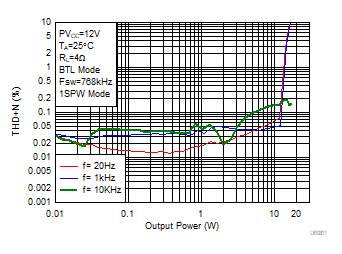
| PVDD = 12V | 10µH+0.68µF | |
| FSW = 768 kHz | 1SPW Modulation | Load = 4Ω |
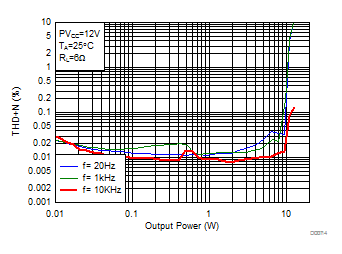
| PVDD = 12V | 4.7µH+0.68µF | |
| FSW = 768 kHz | 1SPW Modulation | Load = 6Ω |
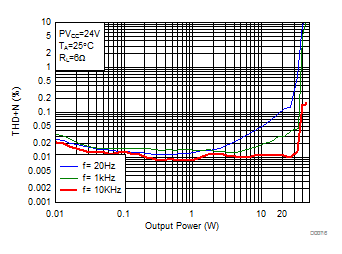
| PVDD = 24V | 10µH+0.68µF | |
| FSW = 768 kHz | 1SPW Modulation | Load = 6Ω |
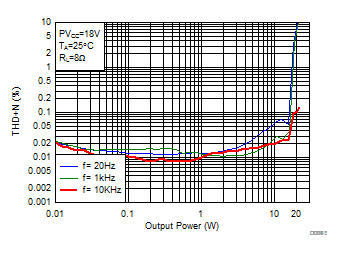
| PVDD = 18V | 10µH+0.68µF | |
| FSW = 768 kHz | 1SPW Modulation | Load = 8Ω |
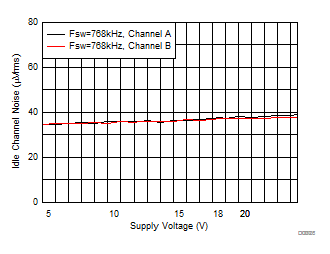
| PVDD = 4.5V~24V | 10µH+0.68µF | |
| FSW = 768 kHz | 1SPW Modulation | Load = 8Ω |
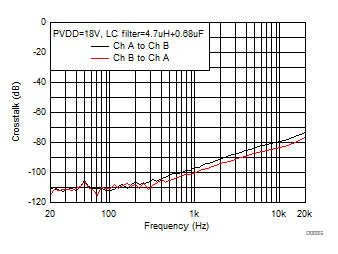
| PVDD = 18V | 10µH+0.68µF | Pout=1W |
| FSW = 768 kHz | 1SPW Modulation | Load = 6Ω |
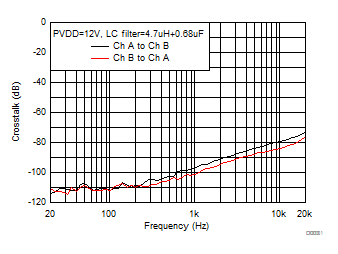
| PVDD = 12V | 4.7µH+0.68µF | Pout=1W |
| FSW = 768 kHz | 1SPW Modulation | Load = 8Ω |
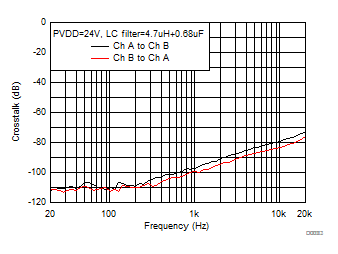
| PVDD = 24V | 10µH+0.68µF | Pout=1W |
| FSW = 768 kHz | 1SPW Modulation | Load = 8Ω |
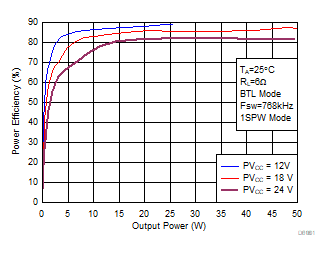
| PVDD = 12V/18V/24V | 10µH+0.68µF | |
| FSW = 768 kHz | 1SPW Modulation | Load = 6Ω |
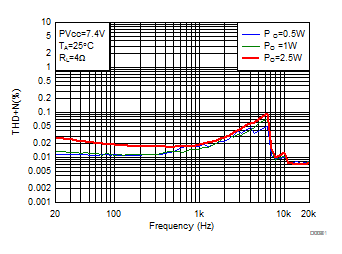
| PVDD = 7.4 V | 4.7µH+0.68µF | |
| FSW = 576 kHz | 1SPW Modulation | Load = 4Ω |
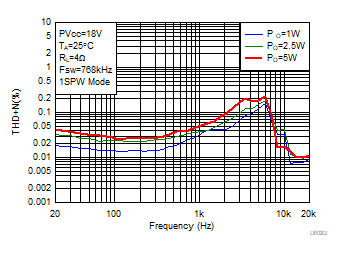
| PVDD = 18 V | 10µH+0.68µF | |
| FSW = 768 kHz | 1SPW Modulation | Load = 4Ω |
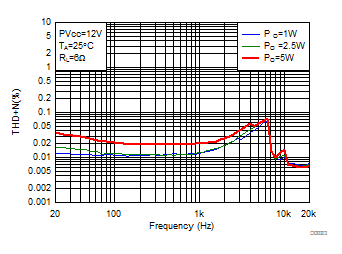
| PVDD = 12 V | 4.7µH+0.68µF | |
| FSW = 768 kHz | 1SPW Modulation | Load = 6Ω |
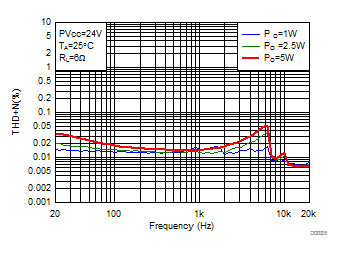
| PVDD = 24 V | 10µH+0.68µF | |
| FSW = 768 kHz | 1SPW Modulation | Load = 6Ω |
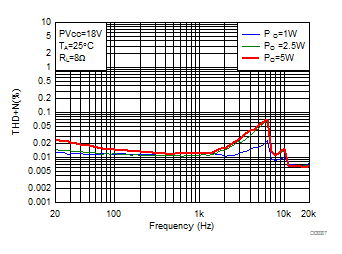
| PVDD = 18 V | 10µH+0.68µF | |
| FSW = 768 kHz | 1SPW Modulation | Load = 8Ω |
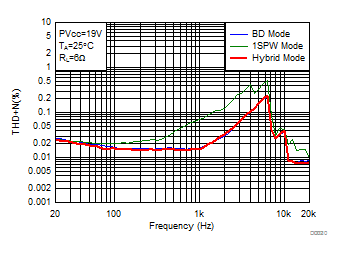
| PVDD = 19 V | 10µH+0.68µF | POUT = 5W |
| FSW = 384 kHz | BD/1SPW/Hybrid | Load = 6Ω |
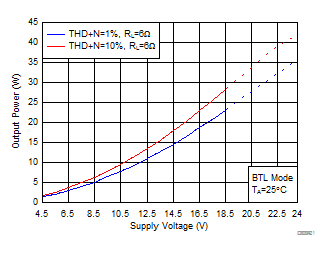
NOTE: Dashed
lines represent thermally limited region for the continuous output power.
Figure 6-14 Output Power vs Supply Voltage-BTL| PVDD = 4.5 V~24V | 10µH+0.68µF | |
| FSW = 768 kHz | 1SPW Modulation | Load = 6Ω |
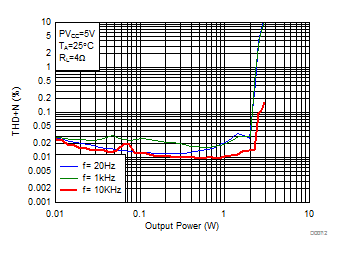
| PVDD = 5V | 4.7µH+0.68µF | |
| FSW = 768 kHz | 1SPW Modulation | Load = 4Ω |
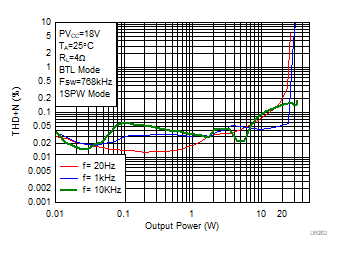
| PVDD = 18V | 10µH+0.68µF | |
| FSW = 768 kHz | 1SPW Modulation | Load = 4Ω |
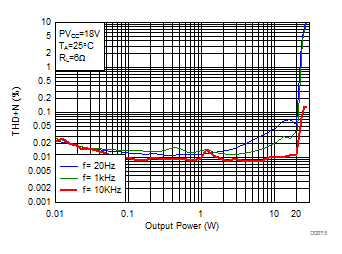
| PVDD = 18V | 10µH+0.68µF | |
| FSW = 768 kHz | 1SPW Modulation | Load = 6Ω |
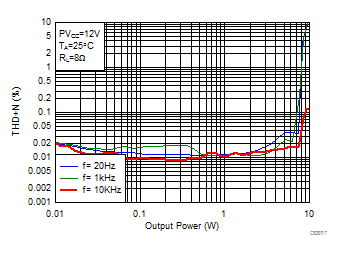
| PVDD = 12V | 4.7µH+0.68µF | |
| FSW = 768 kHz | 1SPW Modulation | Load = 8Ω |
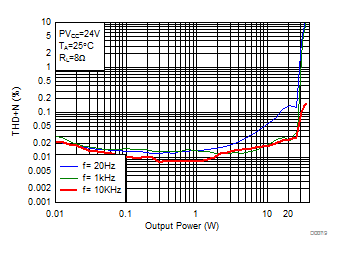
| PVDD = 24V | 10µH+0.68µF | |
| FSW = 768 kHz | 1SPW Modulation | Load = 8Ω |
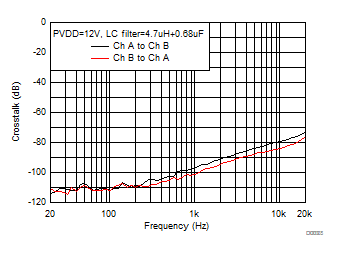
| PVDD = 12V | 4.7µH+0.68µF | Pout=1W |
| FSW = 768 kHz | 1SPW Modulation | Load = 6Ω |
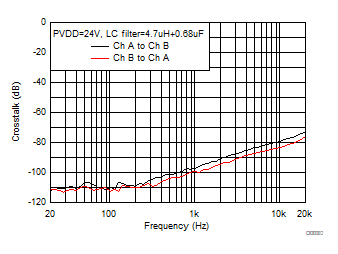
| PVDD = 24V | 10µH+0.68µF | Pout=1W |
| FSW = 768 kHz | 1SPW Modulation | Load = 6Ω |
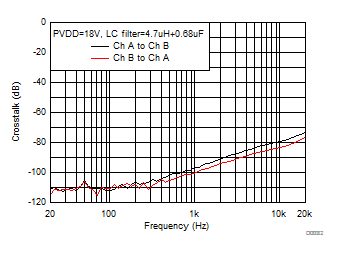
| PVDD = 18V | 10µH+0.68µF | Pout=1W |
| FSW = 768 kHz | 1SPW Modulation | Load = 8Ω |
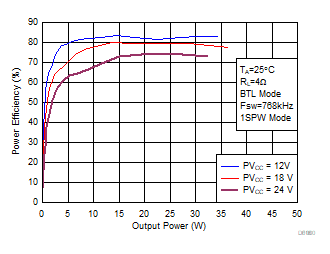
| PVDD = 12V/18V/24V | 10µH+0.68µF | |
| FSW = 768 kHz | 1SPW Modulation | Load = 4Ω |
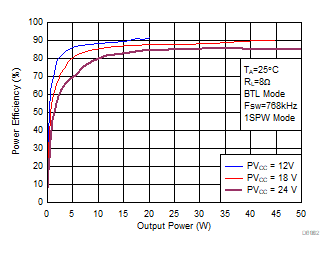
| PVDD = 12V/18V/24V | 10µH+0.68µF | |
| FSW = 768 kHz | 1SPW Modulation | Load = 8Ω |